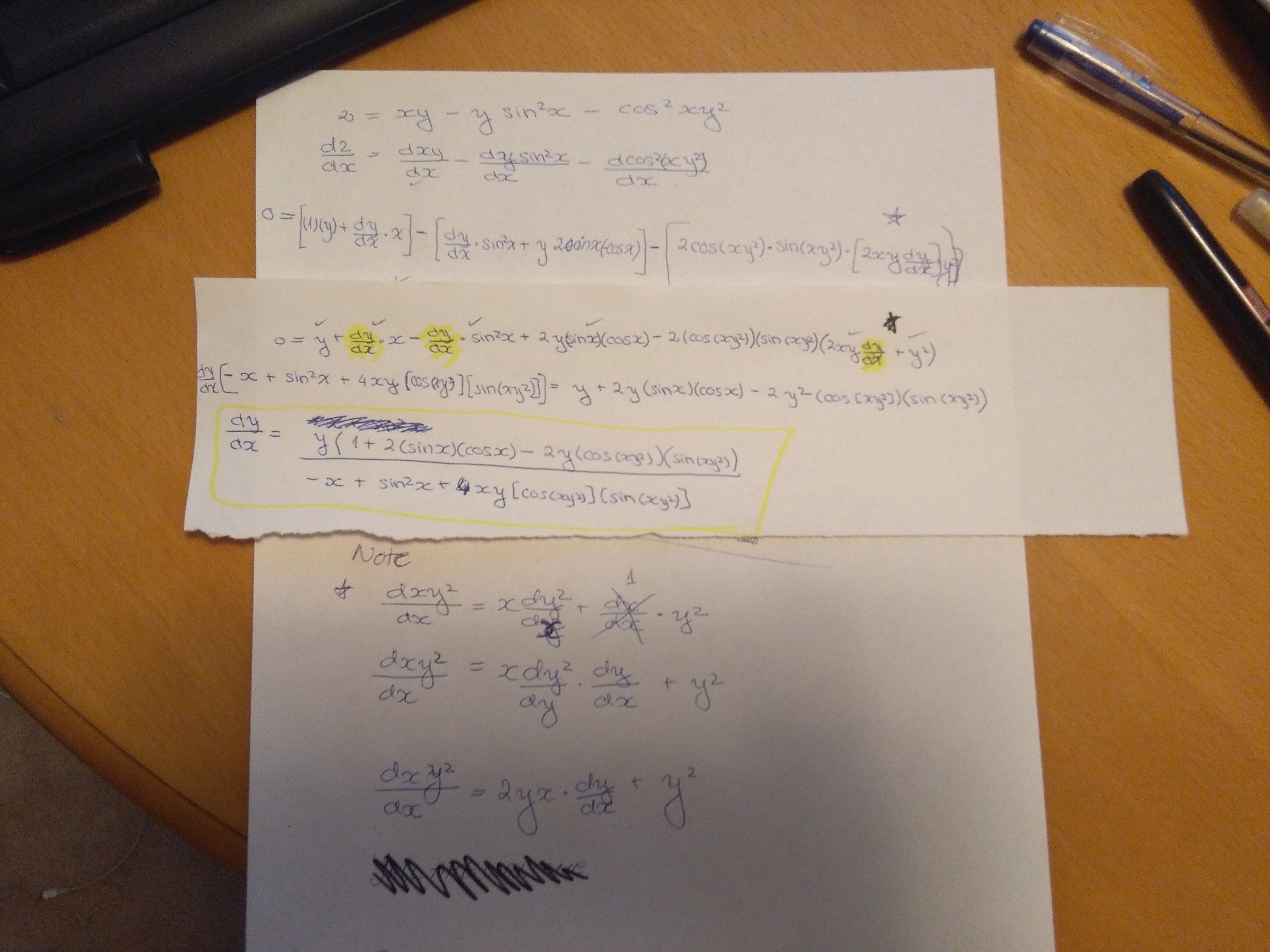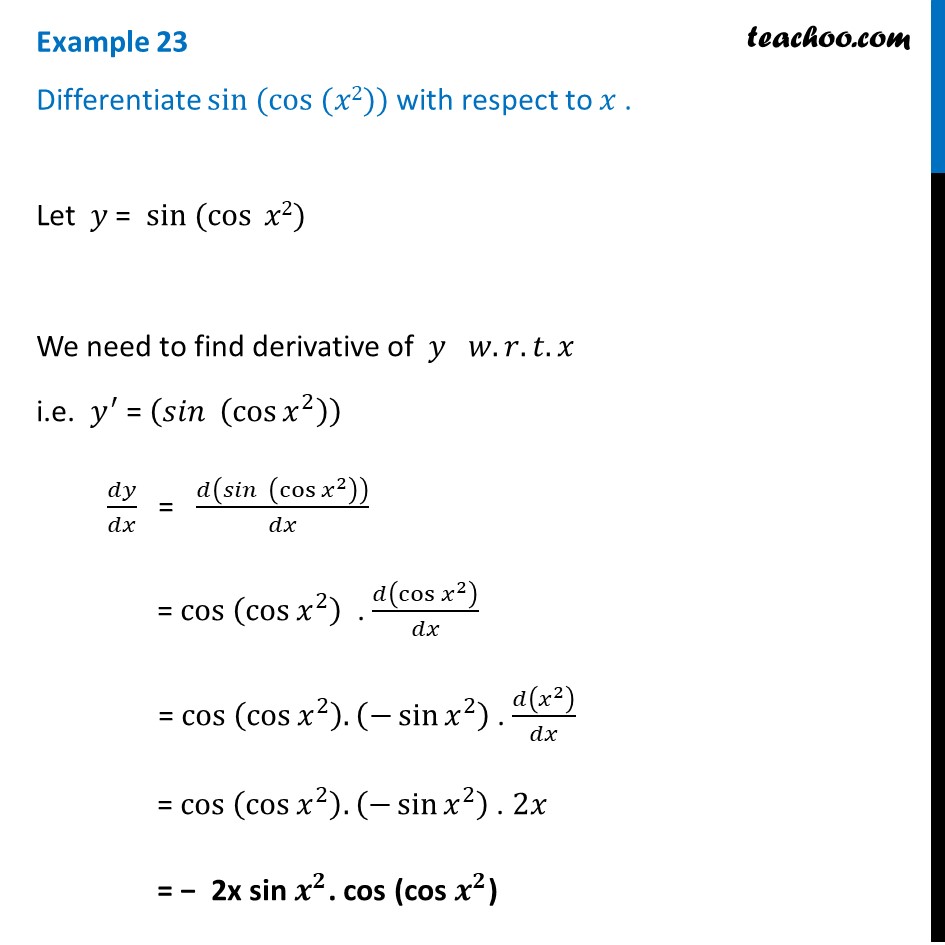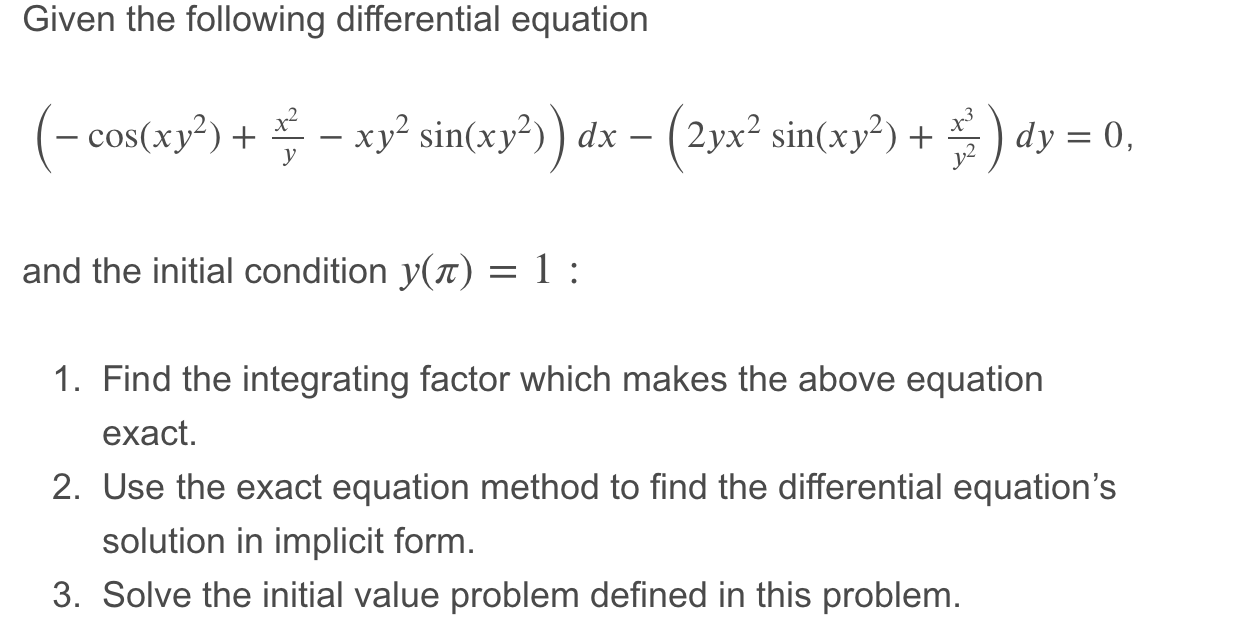Differentiate Cos Xy - D dx cos(xy) = −sin(xy) ⋅ d dx (xy) then the. \int e^x\cos (x)dx \int_{0}^{\pi}\sin(x)dx \sum_{n=0}^{\infty}\frac{3}{2^n} show more The differentiation of trigonometric functions is the mathematical process of finding the derivative of a trigonometric function, or its rate of change. Free math problem solver answers your algebra, geometry, trigonometry, calculus, and statistics. What is the derivative of cos(xy)? Differentiate using the chain rule, which states that d dx [f (g(x))] d d x [f (g (x))] is f '(g(x))g'(x) f ′ (g (x)) g ′ (x) where f (x) = cos(x) f (x) = cos (x). D dx cos(xy) = −(y + x dy dx)sin(xy) use the chain rule: Replace y' y ′ with dy dx d y d x.
Differentiate using the chain rule, which states that d dx [f (g(x))] d d x [f (g (x))] is f '(g(x))g'(x) f ′ (g (x)) g ′ (x) where f (x) = cos(x) f (x) = cos (x). The differentiation of trigonometric functions is the mathematical process of finding the derivative of a trigonometric function, or its rate of change. Free math problem solver answers your algebra, geometry, trigonometry, calculus, and statistics. D dx cos(xy) = −(y + x dy dx)sin(xy) use the chain rule: Replace y' y ′ with dy dx d y d x. What is the derivative of cos(xy)? \int e^x\cos (x)dx \int_{0}^{\pi}\sin(x)dx \sum_{n=0}^{\infty}\frac{3}{2^n} show more D dx cos(xy) = −sin(xy) ⋅ d dx (xy) then the.
\int e^x\cos (x)dx \int_{0}^{\pi}\sin(x)dx \sum_{n=0}^{\infty}\frac{3}{2^n} show more D dx cos(xy) = −sin(xy) ⋅ d dx (xy) then the. What is the derivative of cos(xy)? Replace y' y ′ with dy dx d y d x. The differentiation of trigonometric functions is the mathematical process of finding the derivative of a trigonometric function, or its rate of change. Free math problem solver answers your algebra, geometry, trigonometry, calculus, and statistics. D dx cos(xy) = −(y + x dy dx)sin(xy) use the chain rule: Differentiate using the chain rule, which states that d dx [f (g(x))] d d x [f (g (x))] is f '(g(x))g'(x) f ′ (g (x)) g ′ (x) where f (x) = cos(x) f (x) = cos (x).
Solved Given the following differential equation (cos(xy) +
The differentiation of trigonometric functions is the mathematical process of finding the derivative of a trigonometric function, or its rate of change. D dx cos(xy) = −sin(xy) ⋅ d dx (xy) then the. D dx cos(xy) = −(y + x dy dx)sin(xy) use the chain rule: \int e^x\cos (x)dx \int_{0}^{\pi}\sin(x)dx \sum_{n=0}^{\infty}\frac{3}{2^n} show more Free math problem solver answers your algebra,.
Solved Given the following differential equation ( cos(xy?)
The differentiation of trigonometric functions is the mathematical process of finding the derivative of a trigonometric function, or its rate of change. What is the derivative of cos(xy)? Free math problem solver answers your algebra, geometry, trigonometry, calculus, and statistics. Differentiate using the chain rule, which states that d dx [f (g(x))] d d x [f (g (x))] is f.
Solved If y=x+sin(xy), then
Replace y' y ′ with dy dx d y d x. Differentiate using the chain rule, which states that d dx [f (g(x))] d d x [f (g (x))] is f '(g(x))g'(x) f ′ (g (x)) g ′ (x) where f (x) = cos(x) f (x) = cos (x). Free math problem solver answers your algebra, geometry, trigonometry, calculus, and.
Differentiate (cos x + cos 2x)/(1 cos x)
Differentiate using the chain rule, which states that d dx [f (g(x))] d d x [f (g (x))] is f '(g(x))g'(x) f ′ (g (x)) g ′ (x) where f (x) = cos(x) f (x) = cos (x). Free math problem solver answers your algebra, geometry, trigonometry, calculus, and statistics. Replace y' y ′ with dy dx d y d.
Solved c) cos(xy)=1+siny . Find the dy/dx
\int e^x\cos (x)dx \int_{0}^{\pi}\sin(x)dx \sum_{n=0}^{\infty}\frac{3}{2^n} show more Free math problem solver answers your algebra, geometry, trigonometry, calculus, and statistics. Replace y' y ′ with dy dx d y d x. Differentiate using the chain rule, which states that d dx [f (g(x))] d d x [f (g (x))] is f '(g(x))g'(x) f ′ (g (x)) g ′ (x) where f.
How do you differentiate y=sin(xy)? Socratic
What is the derivative of cos(xy)? D dx cos(xy) = −(y + x dy dx)sin(xy) use the chain rule: Replace y' y ′ with dy dx d y d x. Differentiate using the chain rule, which states that d dx [f (g(x))] d d x [f (g (x))] is f '(g(x))g'(x) f ′ (g (x)) g ′ (x) where f.
How do you implicitly differentiate 2= xyysin^2xcos^2xy^2 ? Socratic
\int e^x\cos (x)dx \int_{0}^{\pi}\sin(x)dx \sum_{n=0}^{\infty}\frac{3}{2^n} show more Differentiate using the chain rule, which states that d dx [f (g(x))] d d x [f (g (x))] is f '(g(x))g'(x) f ′ (g (x)) g ′ (x) where f (x) = cos(x) f (x) = cos (x). D dx cos(xy) = −(y + x dy dx)sin(xy) use the chain rule: Replace y'.
How do you implicitly differentiate (xy)^2+xcos(xy)=ln(x/y)+ytan(xy
The differentiation of trigonometric functions is the mathematical process of finding the derivative of a trigonometric function, or its rate of change. D dx cos(xy) = −sin(xy) ⋅ d dx (xy) then the. D dx cos(xy) = −(y + x dy dx)sin(xy) use the chain rule: Differentiate using the chain rule, which states that d dx [f (g(x))] d d.
Question 2 Differentiate sin (cos (x^2)) Teachoo Examples
D dx cos(xy) = −sin(xy) ⋅ d dx (xy) then the. D dx cos(xy) = −(y + x dy dx)sin(xy) use the chain rule: Free math problem solver answers your algebra, geometry, trigonometry, calculus, and statistics. Differentiate using the chain rule, which states that d dx [f (g(x))] d d x [f (g (x))] is f '(g(x))g'(x) f ′ (g.
Solved Given the following differential equation ( cos(xy?)
D dx cos(xy) = −sin(xy) ⋅ d dx (xy) then the. What is the derivative of cos(xy)? \int e^x\cos (x)dx \int_{0}^{\pi}\sin(x)dx \sum_{n=0}^{\infty}\frac{3}{2^n} show more Replace y' y ′ with dy dx d y d x. D dx cos(xy) = −(y + x dy dx)sin(xy) use the chain rule:
Free Math Problem Solver Answers Your Algebra, Geometry, Trigonometry, Calculus, And Statistics.
The differentiation of trigonometric functions is the mathematical process of finding the derivative of a trigonometric function, or its rate of change. D dx cos(xy) = −(y + x dy dx)sin(xy) use the chain rule: Replace y' y ′ with dy dx d y d x. \int e^x\cos (x)dx \int_{0}^{\pi}\sin(x)dx \sum_{n=0}^{\infty}\frac{3}{2^n} show more
Differentiate Using The Chain Rule, Which States That D Dx [F (G(X))] D D X [F (G (X))] Is F '(G(X))G'(X) F ′ (G (X)) G ′ (X) Where F (X) = Cos(X) F (X) = Cos (X).
What is the derivative of cos(xy)? D dx cos(xy) = −sin(xy) ⋅ d dx (xy) then the.
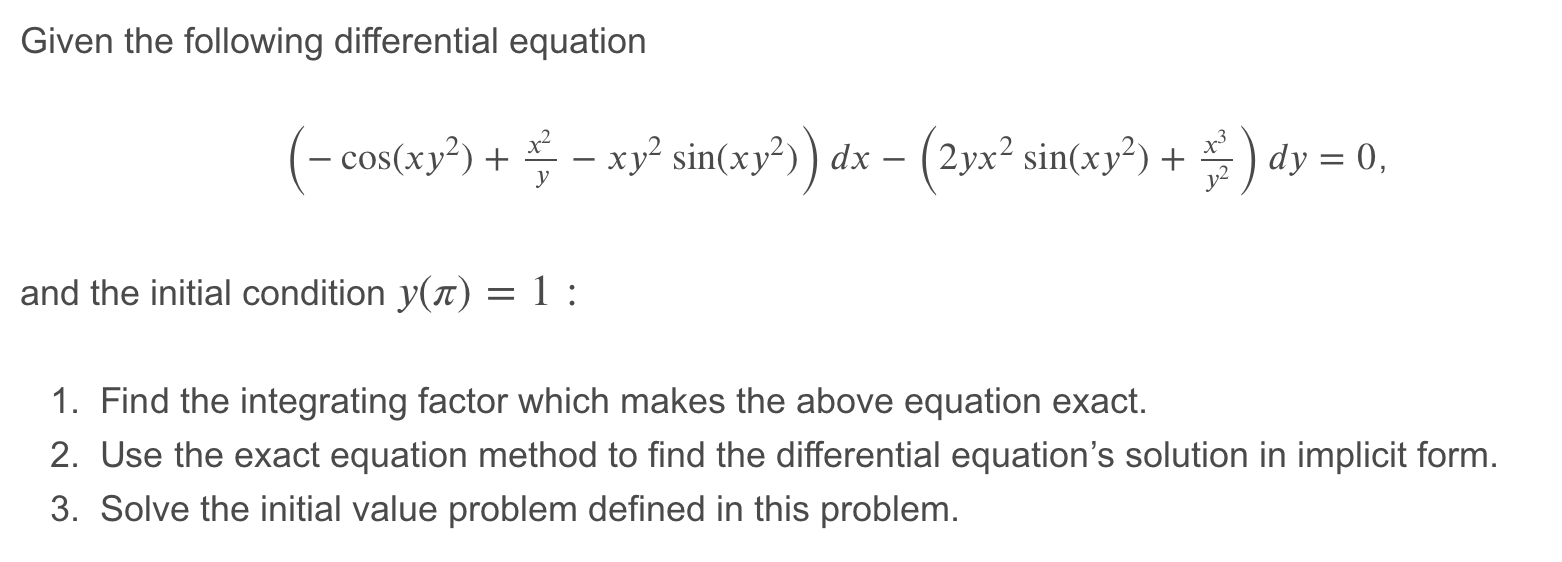
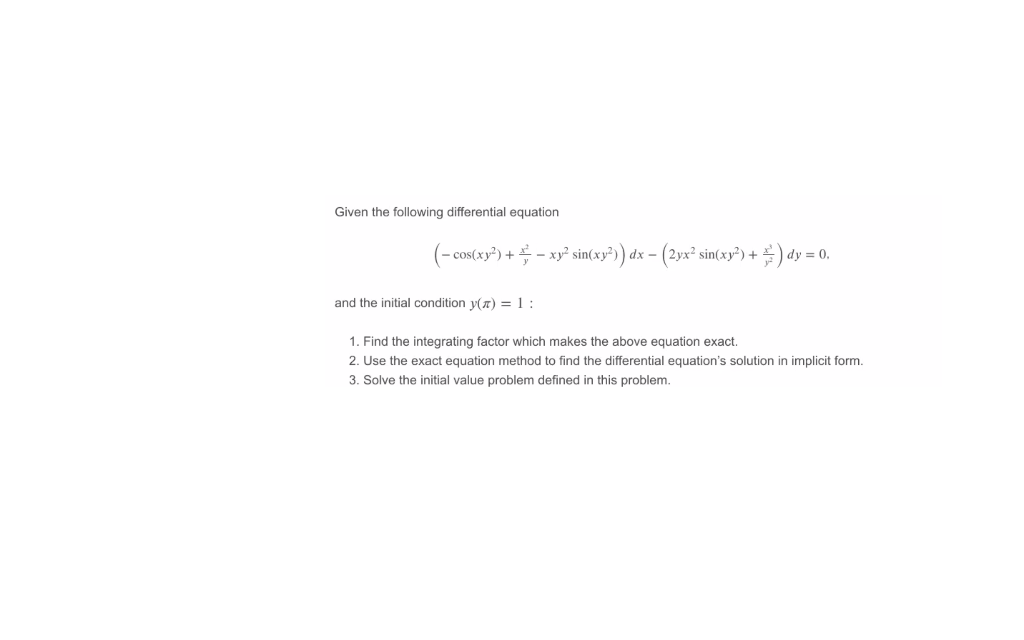


.png)
